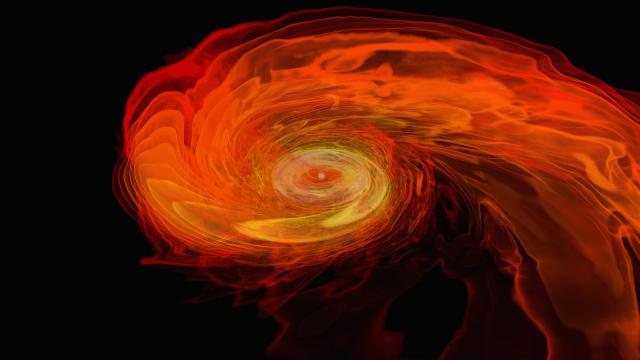If you were to rank the wildest things in the universe, there are a few obvious contenders: Gamma rays, fast radio bursts and quasars, for example. But no list would be complete without black holes and the black hole’s less-dense cousins, the neutron star. These hyper-compressed things can do some mind-boggling warping to the shape of space itself. So, what happens if one were to eat the other?
Image: NASA Goddard Space Flight Center via Flickr
A few scientists think the outcome would be metal as hell… literally. One team of researchers from the Universities of California Los Angeles and San Diego considered the interaction between black holes that formed in the seconds after the Big Bang and neutron stars, dense masses of neutrons only a few kilometres across that happen to be full of pasta. They think much of the universe’s heavy metal could have come from this wild dinner.
The issue is that scientists don’t quite know where certain, quickly-forming elements came from. A Physics World article explains that some scientists thought the answer was certain types of supernovae, and later folks changed their mind and thought it was colliding neutron stars. But the neutron star collisions don’t appear to happen often enough to account for all the metal.
Before we get into this any further, it bears pointing out that this hypothesis requires several leaps of faith. First, it requires that primordial black holes even exist — no one has discovered one yet. Then, it requires the controversial idea that primordial black holes account for some of the universe’s dark matter, the stuff that seems to account for around 5/6ths of the gravity we measure that scientists haven’t been able to detect. Neutron stars are real, though.
So, here’s what happens: A neutron star meets up with a small primordial black hole, at least a hundred million times lighter than the Sun. The black hole is small enough that it would settle into the middle of the neutron star and slowly eat away at its centre like a parasite. This would cause the neutron star to spin faster and spit out some of its nuclear matter without heating it up too much. While crunching the numbers, they felt that this process could account for the mysterious origin of some of the heavy metals whose atomic mass, the sum of their protons and neutrons in their centres, was greater than a hundred. They published their results this month in Physical Review Letters.
The researchers hope that they might be able to detect the imploding neutron stars as kilonovae, or explosions much dimmer than supernovae that could hint to this so-called r-process formation. Specifically, those neutron stars without gravitational waves could potentially help bolster their theory, the authors told Physics World.
Other physicists seem to be in disagreement with the paper’s hypothesis, however, specifically in regards to some of the numbers. The Ohio State University’s Tim Lindenof told Physics World their own calculations didn’t match up, specifically those on how the speeds of neutron stars vary near the centre of the galaxy.
Again, this is just a hypothesis, but sometimes a wild hypothesis is just what you need to whet your appetite for crazy physics.
[PRL via Physics World]
